Sony HX99 vs Panasonic FZ80
The Sony Cyber-shot DSC-HX99 and the Panasonic Lumix DC-FZ80 (labelled Panasonic FZ82 in some countries) are two digital cameras that were announced, respectively, in August 2018 and January 2017. Both the HX99 and the FZ80 are fixed lens compact cameras that are equipped with a 1/2.3-inch sensor. Both cameras offer a resolution of 18 megapixels.
Below is an overview of the main specs of the two cameras as a starting point for the comparison.

Check HX99 offers at
ebay.com

Check FZ80 offers at
ebay.com
Going beyond this snapshot of core features and characteristics, what are the differences between the Sony Cyber-shot DSC-HX99 and the Panasonic Lumix DC-FZ80? Which one should you buy? Read on to find out how these two cameras compare with respect to their body size, their imaging sensors, their shooting features, their input-output connections, and their reception by expert reviewers.
Body comparison
The side-by-side display below illustrates the physical size and weight of the Sony HX99 and the Panasonic FZ80. The two cameras are presented according to their relative size. Three successive views from the front, the top, and the rear are shown. All width, height and depth dimensions are rounded to the nearest millimeter.
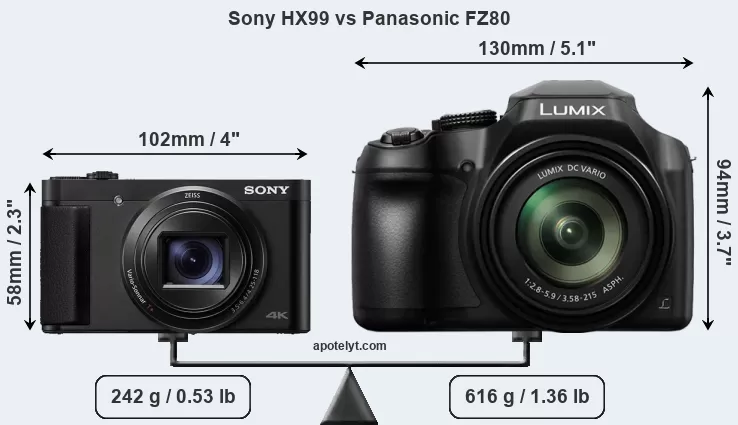
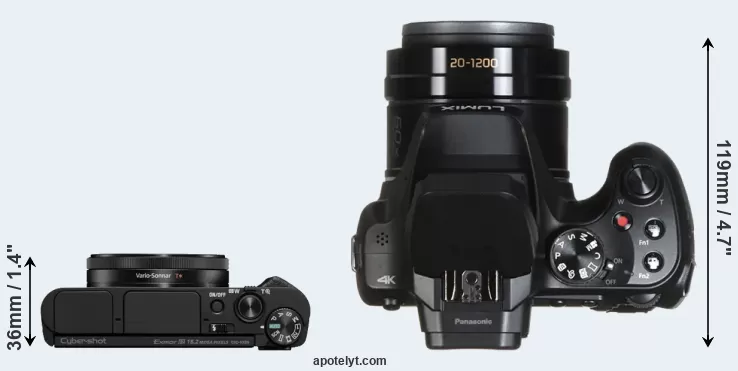
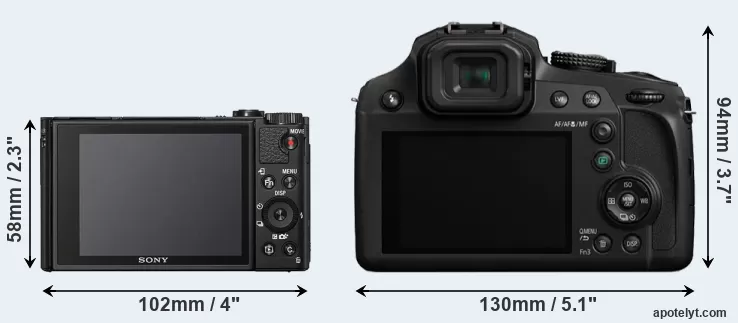
If the front view area (width x height) of the cameras is taken as an aggregate measure of their size, the Panasonic FZ80 is considerably larger (107 percent) than the Sony HX99. Moreover, the FZ80 is substantially heavier (155 percent) than the HX99. In this context, it is worth noting that neither the HX99 nor the FZ80 are weather-sealed.
Concerning battery life, the HX99 gets 370 shots out of its Sony NP-BX1 battery, while the FZ80 can take 330 images on a single charge of its Panasonic DMW-BMB9 power pack. The battery packs of both cameras can be charged via USB, which can be very convenient when travelling.
The adjacent table lists the principal physical characteristics of the two cameras alongside a wider set of alternatives. In case you want to display and compare another camera duo, you can use the CAM-parator app to select your camera combination among a large number of options.

| Camera Model |
Camera Width |
Camera Height |
Camera Depth |
Camera Weight |
Battery Life |
Weather Sealing |
Camera Launch |
Launch Price |
Street Price |
||
|---|---|---|---|---|---|---|---|---|---|---|---|
| 1. | Sony HX99 | 102 mm | 58 mm | 36 mm | 242 g | 370 | n | Aug 2018 | US$ 449 | ebay.com | |
| 2. | Panasonic FZ80 | 130 mm | 94 mm | 119 mm | 616 g | 330 | n | Jan 2017 | US$ 399 | ebay.com | |
| 3. | Canon SX70 | 127 mm | 91 mm | 117 mm | 608 g | 325 | n | Sep 2018 | US$ 549 | amazon.com | |
| 4. | Canon SX730 | 110 mm | 64 mm | 40 mm | 300 g | 250 | n | Apr 2017 | US$ 399 | ebay.com | |
| 5. | Canon SX740 | 110 mm | 64 mm | 40 mm | 299 g | 265 | n | Jul 2018 | US$ 399 | amazon.com | |
| 6. | Nikon A1000 | 114 mm | 72 mm | 41 mm | 330 g | 250 | n | Jan 2019 | US$ 429 | ebay.com | |
| 7. | Nikon W300 | 112 mm | 66 mm | 29 mm | 231 g | 280 | Y | May 2017 | US$ 389 | ebay.com | |
| 8. | Panasonic TS7 | 117 mm | 76 mm | 37 mm | 319 g | 300 | Y | May 2018 | US$ 449 | ebay.com | |
| 9. | Panasonic ZS70 | 112 mm | 67 mm | 41 mm | 322 g | 380 | n | Apr 2017 | US$ 449 | ebay.com | |
| 10. | Sony HX90V | 102 mm | 58 mm | 36 mm | 245 g | 360 | n | Apr 2015 | US$ 429 | ebay.com | |
| 11. | Sony HX95 | 102 mm | 58 mm | 36 mm | 242 g | 370 | n | Aug 2018 | US$ 429 | ebay.com | |
| 12. | Sony HX350 | 130 mm | 93 mm | 103 mm | 652 g | 300 | n | Dec 2016 | US$ 449 | ebay.com | |
| 13. | Sony HX400V | 130 mm | 93 mm | 103 mm | 660 g | 300 | n | Feb 2014 | US$ 499 | ebay.com | |
| 14. | Sony WX800 | 102 mm | 58 mm | 36 mm | 233 g | 370 | n | Oct 2018 | US$ 399 | ebay.com | |
| Note: Measurements and pricing do not include easily detachable parts, such as add-on or interchangeable lenses or optional viewfinders. | |||||||||||
The price is, of course, an important factor in any camera decision. The listed launch prices provide an indication of the market segment that the manufacturer of the cameras have been targeting. The FZ80 was launched at a somewhat lower price (by 11 percent) than the HX99, which makes it more attractive for photographers on a tight budget. Usually, retail prices stay at first close to the launch price, but after several months, discounts become available. Later in the product cycle and, in particular, when the replacement model is about to appear, further discounting and stock clearance sales often push the camera price considerably down.
Sensor comparison
The size of the sensor inside a digital camera is one of the key determinants of image quality. A large sensor will tend to have larger individual pixels that provide better low-light sensitivity, wider dynamic range, and richer color-depth than smaller pixel-units in a sensor of the same technological generation. Further, a large sensor camera will give the photographer additional creative options when using shallow depth-of-field to isolate a subject from its background. On the downside, larger sensors tend to be more expensive and lead to bigger and heavier cameras and lenses.
Both cameras under consideration feature a 1/2.3-inch sensor and have a format factor (sometimes also referred to as "crop factor") of 5.6. Within the spectrum of camera sensors, this places the review cameras among the smaller-sensor digicams that favor affordability and compact design. Both cameras feature a native aspect ratio (sensor width to sensor height) of 4:3.
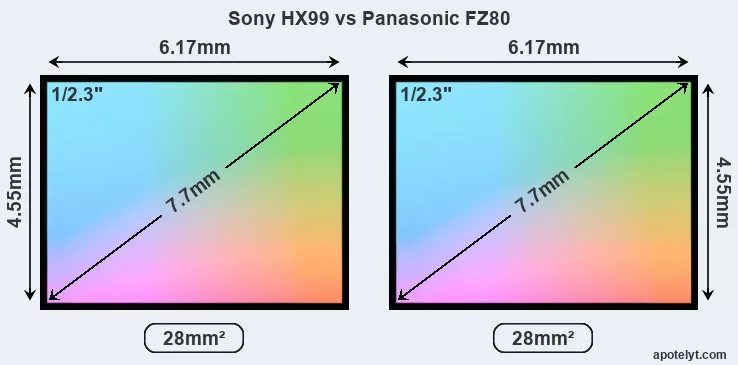
The two cameras under review do not only share the same sensor size, but also offer an identical resolution of 18 megapixels. This similarity in sensor specs implies that both the HX99 and the FZ80 have the same pixel density, as well as the same pixel size. It should, however, be noted that the HX99 is a somewhat more recent model (by 1 year and 7 months) than the FZ80, and its sensor might have benefitted from technological advances during this time. Coming back to sensor resolution, it should be mentioned that neither of the two cameras has an anti-alias filter installed, so they are able to capture all the detail the sensor resolves.
The Sony Cyber-shot DSC-HX99 has a native sensitivity range from ISO 80 to ISO 3200, which can be extended to ISO 80-6400. The Panasonic Lumix DC-FZ80 offers exactly the same ISO settings.
In terms of underlying technology, the HX99 is build around a CMOS sensor, while the FZ80 uses a BSI-CMOS imager. Both cameras use a Bayer filter for capturing RGB colors on a square grid of photosensors. This arrangement is found in most digital cameras.
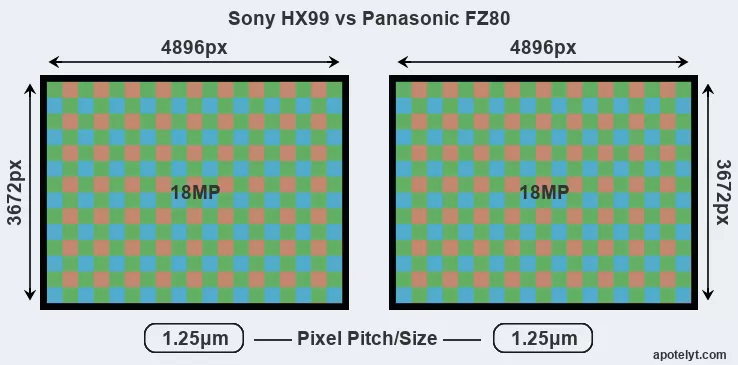
For many cameras, data on sensor performance has been reported by DXO Mark. This service is based on lab testing and assigns an overall score to each camera sensor, as well as ratings for dynamic range ("DXO Landscape"), color depth ("DXO Portrait"), and low-light sensitivity ("DXO Sports"). The adjacent table reports on the physical sensor characteristics and the outcomes of the DXO sensor quality tests for a sample of comparator-cameras.

| Camera Model |
Sensor Class |
Resolution (MP) |
Horiz. Pixels |
Vert. Pixels |
Video Format |
DXO Portrait |
DXO Landscape |
DXO Sports |
DXO Overall |
||
|---|---|---|---|---|---|---|---|---|---|---|---|
| 1. | Sony HX99 | 1/2.3 | 18.0 | 4896 | 3672 | 4K/30p | 20.6 | 12.1 | 1058 | 51 | |
| 2. | Panasonic FZ80 | 1/2.3 | 18.0 | 4896 | 3672 | 4K/30p | 20.5 | 11.9 | 900 | 49 | |
| 3. | Canon SX70 | 1/2.3 | 20.2 | 5184 | 3888 | 4K/30p | 20.6 | 12.1 | 1063 | 51 | |
| 4. | Canon SX730 | 1/2.3 | 20.2 | 5184 | 3888 | 1080/60p | 20.5 | 11.9 | 924 | 50 | |
| 5. | Canon SX740 | 1/2.3 | 20.2 | 5184 | 3888 | 4K/30p | 20.6 | 12.1 | 1050 | 51 | |
| 6. | Nikon A1000 | 1/2.3 | 15.9 | 4608 | 3456 | 4K/30p | 20.7 | 12.2 | 1095 | 52 | |
| 7. | Nikon W300 | 1/2.3 | 15.9 | 4608 | 3456 | 4K/30p | 20.5 | 12.0 | 938 | 50 | |
| 8. | Panasonic TS7 | 1/2.3 | 20.2 | 5184 | 3888 | 4K/30p | 20.6 | 12.1 | 1028 | 51 | |
| 9. | Panasonic ZS70 | 1/2.3 | 20.2 | 5184 | 3888 | 4K/30p | 19.1 | 10.6 | 106 | 36 | |
| 10. | Sony HX90V | 1/2.3 | 18.0 | 4896 | 3672 | 1080/60p | 20.2 | 11.6 | 738 | 47 | |
| 11. | Sony HX95 | 1/2.3 | 18.0 | 4896 | 3672 | 4K/30p | 20.6 | 12.1 | 1057 | 51 | |
| 12. | Sony HX350 | 1/2.3 | 19.9 | 5152 | 3864 | 1080/60p | 20.5 | 11.9 | 896 | 49 | |
| 13. | Sony HX400V | 1/2.3 | 20.2 | 5184 | 3888 | 1080/60p | 20.1 | 11.4 | 629 | 45 | |
| 14. | Sony WX800 | 1/2.3 | 18.0 | 4896 | 3672 | 4K/30p | 20.6 | 12.2 | 1070 | 51 | |
| Note: DXO values in italics represent estimates based on sensor size and age. | |||||||||||
Many modern cameras are not only capable of taking still images, but also of capturing video footage. Both cameras under consideration have a sensor with sufficiently fast read-out times for moving pictures, and both provide the same movie specifications (4K/30p).
Feature comparison
Apart from body and sensor, cameras can and do differ across a variety of features. The two cameras under review are similar with respect to both having an electronic viewfinder. However, the one in the FZ80 offers a substantially higher resolution than the one in the HX99 (1166k vs 638k dots). The adjacent table lists some of the other core features of the Sony HX99 and Panasonic FZ80 along with similar information for a selection of comparators.

| Camera Model |
Viewfinder (Type or 000 dots) |
Control Panel (yes/no) |
LCD Specifications (inch/000 dots) |
LCD Attach- ment |
Touch Screen (yes/no) |
Max Shutter Speed * |
Max Shutter Flaps * |
Built-in Flash (yes/no) |
Built-in Image Stab |
||
|---|---|---|---|---|---|---|---|---|---|---|---|
| 1. | Sony HX99 | 638 | n | 3.0 / 922 | tilting | Y | 1/2000s | 10.0/s | Y | Y | |
| 2. | Panasonic FZ80 | 1166 | n | 3.0 / 1040 | fixed | Y | 1/2000s | 10.0/s | Y | Y | |
| 3. | Canon SX70 | 2360 | n | 3.0 / 922 | swivel | n | 1/2000s | 10.0/s | Y | Y | |
| 4. | Canon SX730 | none | n | 3.0 / 922 | tilting | n | 1/3200s | 5.9/s | Y | Y | |
| 5. | Canon SX740 | none | n | 3.0 / 922 | tilting | n | 1/3200s | 10.0/s | Y | Y | |
| 6. | Nikon A1000 | 1166 | n | 3.0 / 1036 | tilting | Y | 1/4000s | 7.0/s | Y | Y | |
| 7. | Nikon W300 | none | n | 3.0 / 921 | fixed | n | 1/4000s | 7.0/s | Y | Y | |
| 8. | Panasonic TS7 | 1170 | n | 3.0 / 1040 | fixed | n | 1/1300s | 10.0/s | Y | Y | |
| 9. | Panasonic ZS70 | 1166 | n | 3.0 / 1040 | tilting | Y | 1/2000s | 10.0/s | Y | Y | |
| 10. | Sony HX90V | 638 | n | 3.0 / 921 | tilting | n | 1/2000s | 10.0/s | Y | Y | |
| 11. | Sony HX95 | 638 | n | 3.0 / 922 | tilting | n | 1/2000s | 10.0/s | Y | Y | |
| 12. | Sony HX350 | 202 | n | 3.0 / 922 | tilting | n | 1/4000s | 10.0/s | Y | Y | |
| 13. | Sony HX400V | 210 | n | 3.0 / 921 | tilting | n | 1/4000s | 10.0/s | Y | Y | |
| 14. | Sony WX800 | none | n | 3.0 / 922 | tilting | Y | 1/2000s | 10.0/s | Y | Y | |
| Note: *) Information refers to the mechanical shutter, unless the camera only has an electronic one. | |||||||||||
The reported shutter speed information refers to the use of the mechanical shutter. Yet, some cameras only have an electronic shutter, while others have an electronic shutter in addition to a mechanical one. In fact, the FZ80 is one of those camera that have an additional electronic shutter, which makes completely silent shooting possible. However, this mode is less suitable for photographing moving objects (risk of rolling shutter) or shooting under artificial light sources (risk of flickering).
Both the HX99 and the FZ80 have zoom lenses built in. The HX99 has a 24-720mm f/3.5-6.4 optic and the FZ80 offers a 20-1200mm f/2.8-5.9 (focal lengths in full frame equivalent terms). Hence, the Panasonic provides a wider angle of view at the short end, as well as more tele-photo reach at the long end than the Sony. The FZ80 offers the faster maximum aperture.
The HX99 writes its imaging data to SDXC or Memory Stick PRO Duo cards, while the FZ80 uses SDXC cards. Both cameras can use UHS-I cards, which provide for Ultra High Speed data transfer of up to 104 MB/s.
Connectivity comparison
For some imaging applications, the extent to which a camera can communicate with its environment can be an important aspect in the camera decision process. The table below provides an overview of the connectivity of the Sony Cyber-shot DSC-HX99 and Panasonic Lumix DC-FZ80 and, in particular, the interfaces the cameras (and selected comparators) provide for accessory control and data transfer.

| Camera Model |
Hotshoe Port |
Internal Mic / Speaker |
Microphone Port |
Headphone Port |
HDMI Port |
USB Port |
WiFi Support |
NFC Support |
Bluetooth Support |
||
|---|---|---|---|---|---|---|---|---|---|---|---|
| 1. | Sony HX99 | - | stereo / mono | - | - | micro | 2.0 | Y | Y | Y | |
| 2. | Panasonic FZ80 | Y | stereo / mono | - | - | micro | 2.0 | Y | - | - | |
| 3. | Canon SX70 | - | stereo / mono | Y | - | micro | 2.0 | Y | - | Y | |
| 4. | Canon SX730 | - | stereo / mono | - | - | micro | 2.0 | Y | Y | Y | |
| 5. | Canon SX740 | - | stereo / mono | - | - | micro | 2.0 | Y | - | Y | |
| 6. | Nikon A1000 | - | stereo / mono | - | - | micro | 2.0 | Y | - | Y | |
| 7. | Nikon W300 | - | stereo / mono | - | - | micro | 2.0 | Y | - | Y | |
| 8. | Panasonic TS7 | - | stereo / mono | - | - | micro | 2.0 | Y | - | - | |
| 9. | Panasonic ZS70 | - | stereo / mono | - | - | micro | 2.0 | Y | - | - | |
| 10. | Sony HX90V | - | stereo / mono | - | - | micro | 2.0 | Y | Y | - | |
| 11. | Sony HX95 | - | stereo / mono | - | - | micro | 2.0 | Y | Y | Y | |
| 12. | Sony HX350 | - | stereo / mono | - | - | micro | 2.0 | - | - | - | |
| 13. | Sony HX400V | Y | stereo / mono | - | - | micro | 2.0 | Y | Y | - | |
| 14. | Sony WX800 | - | stereo / mono | - | - | micro | 2.0 | Y | Y | - |
It is notable that the FZ80 has a hotshoe, which makes it possible to easily attach optional accessories, such as an external flash gun. The HX99 does not feature such an accessory-socket.
Both the HX99 and the FZ80 have been discontinued, but can regularly be found used on ebay. Neither of the two has a direct successor, so they represent the end of the respective camera lines from Sony and Panasonic. Further information on the features and operation of the HX99 and FZ80 can be found, respectively, in the Sony HX99 Manual (free pdf) or the online Panasonic FZ80 Manual.
Review summary
So how do things add up? Is there a clear favorite between the Sony HX99 and the Panasonic FZ80? Which camera is better? Below is a summary of the relative strengths of each of the two contestants.

Advantages of the Sony Cyber-shot DSC-HX99:
- More flexible LCD: Has a tilting screen for odd-angle shots in landscape orientation.
- More selfie-friendly: Has an articulated screen that can be turned to be front-facing.
- More compact: Is smaller (102x58mm vs 130x94mm) and thus needs less room in the bag.
- Less heavy: Is lighter (by 374g or 61 percent) and hence easier to carry around.
- Longer lasting: Can take more shots (370 versus 330) on a single battery charge.
- Easier device pairing: Supports NFC for fast wireless image transfer over short distances.
- Easier wireless transfer: Supports Bluetooth for image sharing without cables.
- More modern: Is somewhat more recent (announced 1 year and 7 months after the FZ80).

Arguments in favor of the Panasonic Lumix DC-FZ80:
- More detailed viewfinder: Has higher resolution electronic viewfinder (1166k vs 638k dots).
- More detailed LCD: Has a higher resolution rear screen (1040k vs 922k dots).
- Less disturbing: Has an electronic shutter option for completely silent shooting.
- Better light gathering: Has a lens with a wider maximum aperture (f/2.8 vs f/3.5).
- Wider view: Has a wider-angle lens that facilitates landscape or interior shots.
- More tele-reach: Has a longer tele-lens for perspective compression and subject magnification.
- Better lighting: Features a hotshoe and can thus hold and trigger an external flash gun.
- More affordable: Was released into a lower priced segment (11 percent cheaper at launch).
- More heavily discounted: Has been on the market for longer (launched in January 2017).
If the number of relative strengths (bullet points above) is taken as a guide, the FZ80 comes out slightly ahead of the HX99 (9 : 8 points). However, the relevance of individual strengths will vary across photographers, so that you might want to apply your own weighing scheme to the summary points when reflecting and deciding on a new camera. A professional wildlife photographer will view the differences between cameras in a way that diverges from the perspective of a family photog, and a person interested in architecture has distinct needs from a sports shooter. Hence, the decision which camera is best and worth buying is often a very personal one.
How about other alternatives? Do the specifications of the Sony HX99 and the Panasonic FZ80 place the cameras among the top in their class? Find out in the latest Best Superzoom Camera listing whether the two cameras rank among the cream of the crop.
In any case, while the comparison of the spec-sheets of cameras can offer a general idea of their imaging potential, it says little about, for example, the shooting experience and imaging performance of the HX99 and the FZ80 in practical situations. User reviews, such as those found at amazon, can sometimes inform about these issues, but such feedback is often incomplete, inconsistent, and biased.
Expert reviews
This is why hands-on reviews by experts are important. The following table reports the overall ratings of the cameras as published by some of the major camera review sites (amateurphotographer [AP], cameralabs [CL], digitalcameraworld [DCW], dpreview [DPR], ephotozine [EPZ], photographyblog [PB]). As can be seen, the professional reviewers agree in many cases on the quality of different cameras, but sometimes their assessments diverge, reinforcing the earlier point that a camera decision is often a very personal choice.

| Camera Model |
AP score |
CL score |
DCW score |
DPR score |
EPZ score |
PB score |
Camera Launch |
Launch Price |
Street Price |
||
|---|---|---|---|---|---|---|---|---|---|---|---|
| 1. | Sony HX99 | .. | .. | .. | .. | 4/5 | 4.5/5 | Aug 2018 | US$ 449 | ebay.com | |
| 2. | Panasonic FZ80 | .. | + + | .. | .. | 4.5/5 | 4.5/5 | Jan 2017 | US$ 399 | ebay.com | |
| 3. | Canon SX70 | .. | + + | 3.5/5 | .. | 3.5/5 | 3.5/5 | Sep 2018 | US$ 549 | amazon.com | |
| 4. | Canon SX730 | .. | + | .. | .. | 4/5 | 4/5 | Apr 2017 | US$ 399 | ebay.com | |
| 5. | Canon SX740 | .. | + | 3.5/5 | .. | 4/5 | 4/5 | Jul 2018 | US$ 399 | amazon.com | |
| 6. | Nikon A1000 | .. | + + | 3.5/5 | .. | 3.5/5 | 3/5 | Jan 2019 | US$ 429 | ebay.com | |
| 7. | Nikon W300 | .. | + | .. | .. | 4/5 | 4/5 | May 2017 | US$ 389 | ebay.com | |
| 8. | Panasonic TS7 | .. | + | .. | .. | .. | 3.5/5 | May 2018 | US$ 449 | ebay.com | |
| 9. | Panasonic ZS70 | .. | + + | .. | .. | 4/5 | 4/5 | Apr 2017 | US$ 449 | ebay.com | |
| 10. | Sony HX90V | 4/5 | + + | .. | .. | 4/5 | 4.5/5 | Apr 2015 | US$ 429 | ebay.com | |
| 11. | Sony HX95 | .. | .. | .. | .. | .. | .. | Aug 2018 | US$ 429 | ebay.com | |
| 12. | Sony HX350 | .. | .. | .. | .. | .. | 4/5 | Dec 2016 | US$ 449 | ebay.com | |
| 13. | Sony HX400V | 4/5 | + + | .. | .. | 4/5 | 4/5 | Feb 2014 | US$ 499 | ebay.com | |
| 14. | Sony WX800 | .. | .. | .. | .. | .. | .. | Oct 2018 | US$ 399 | ebay.com | |
| Note: (+ +) highly recommended; (+) recommended; (o) reviewed; (..) not available. | |||||||||||
The above review scores should be interpreted with care, though. The ratings are only valid when referring to cameras in the same category and of the same age. Thus, a score needs to be put into the context of the launch date and the launch price of the camera, and comparing ratings of very distinct cameras or ones that are far apart in terms of their release date have little meaning. Also, kindly note that some of the listed sites have over time developped their review approaches and their reporting style.

Check HX99 offers at
ebay.com

Check FZ80 offers at
ebay.com
Other camera comparisons
Did this review help to inform your camera decision process? In case you are interested in seeing how other cameras pair up, just make a corresponding selection in the search boxes below. Alternatively, you can follow any of the listed hyperlinks for comparisons that others found interesting.
- Canon 30D vs Sony HX99
- Canon Rebel vs Panasonic FZ80
- Canon SX610 vs Sony HX99
- Canon SX70 vs Panasonic FZ80
- Fujifilm GFX 100S vs Sony HX99
- Fujifilm X-T2 vs Sony HX99
- Fujifilm XF10 vs Sony HX99
- Nikon D7000 vs Panasonic FZ80
- Panasonic FZ100 vs Sony HX99
- Panasonic FZ80 vs Panasonic L1
- Panasonic FZ80 vs Sony A7 II
- Panasonic FZ80 vs Sony NEX-6
Specifications: Sony HX99 vs Panasonic FZ80
Below is a side-by-side comparison of the specs of the two cameras to facilitate a quick review of their differences and common features.
| Camera Model | Sony HX99 | Panasonic FZ80 |
|---|---|---|
| Camera Type | Fixed lens compact camera | Fixed lens compact camera |
| Camera Lens | 24-720mm f/3.5-6.4 | 20-1200mm f/2.8-5.9 |
| Launch Date | August 2018 | January 2017 |
| Launch Price | USD 449 | USD 399 |
| Sensor Specs | Sony HX99 | Panasonic FZ80 |
| Sensor Technology | CMOS | BSI-CMOS |
| Sensor Format | 1/2.3" Sensor | 1/2.3" Sensor |
| Sensor Size | 6.17 x 4.55 mm | 6.17 x 4.55 mm |
| Sensor Area | 28.0735 mm2 | 28.0735 mm2 |
| Sensor Diagonal | 7.7 mm | 7.7 mm |
| Crop Factor | 5.6x | 5.6x |
| Sensor Resolution | 18 Megapixels | 18 Megapixels |
| Image Resolution | 4896 x 3672 pixels | 4896 x 3672 pixels |
| Pixel Pitch | 1.25 μm | 1.25 μm |
| Pixel Density | 64.04 MP/cm2 | 64.04 MP/cm2 |
| Moiré control | no AA filter | no AA filter |
| Movie Capability | 4K/30p Video | 4K/30p Video |
| ISO Setting | 80 - 3,200 ISO | 80 - 3,200 ISO |
| ISO Boost | 80 - 6,400 ISO | 80 - 6,400 ISO |
| Image Processor | BIONZ X | Venus |
| Screen Specs | Sony HX99 | Panasonic FZ80 |
| Viewfinder Type | Electronic viewfinder | Electronic viewfinder |
| Viewfinder Field of View | 100% | 100% |
| Viewfinder Magnification | 0.46x | |
| Viewfinder Resolution | 638k dots | 1166k dots |
| LCD Framing | Live View | Live View |
| Rear LCD Size | 3.0inch | 3.0inch |
| LCD Resolution | 922k dots | 1040k dots |
| LCD Attachment | Tilting screen | Fixed screen |
| Touch Input | Touchscreen | Touchscreen |
| Shooting Specs | Sony HX99 | Panasonic FZ80 |
| Focus System | Contrast-detect AF | Contrast-detect AF |
| Manual Focusing Aid | no Peaking Feature | Focus Peaking |
| Max Shutter Speed (mechanical) | 1/2000s | 1/2000s |
| Continuous Shooting | 10 shutter flaps/s | 10 shutter flaps/s |
| Electronic Shutter | no E-Shutter | up to 1/16000s |
| Fill Flash | Built-in Flash | Built-in Flash |
| Storage Medium | MS or SDXC cards | SDXC cards |
| Single or Dual Card Slots | Single card slot | Single card slot |
| UHS card support | UHS-I | UHS-I |
| Connectivity Specs | Sony HX99 | Panasonic FZ80 |
| External Flash | no Hotshoe | Hotshoe |
| USB Connector | USB 2.0 | USB 2.0 |
| HDMI Port | micro HDMI | micro HDMI |
| Wifi Support | Wifi built-in | Wifi built-in |
| Near-Field Communication | NFC built-in | no NFC |
| Bluetooth Support | Bluetooth built-in | no Bluetooth |
| Body Specs | Sony HX99 | Panasonic FZ80 |
| Battery Type | Sony NP-BX1 | Panasonic DMW-BMB9 |
| Battery Life (CIPA) | 370 shots per charge | 330 shots per charge |
| In-Camera Charging | USB charging | USB charging |
| Body Dimensions |
102 x 58 x 36 mm (4.0 x 2.3 x 1.4 in) |
130 x 94 x 119 mm (5.1 x 3.7 x 4.7 in) |
| Camera Weight | 242 g (8.5 oz) | 616 g (21.7 oz) |

Check HX99 offers at
ebay.com

Check FZ80 offers at
ebay.com
Did you notice an error on this page? If so, please get in touch, so that we can correct the information.

